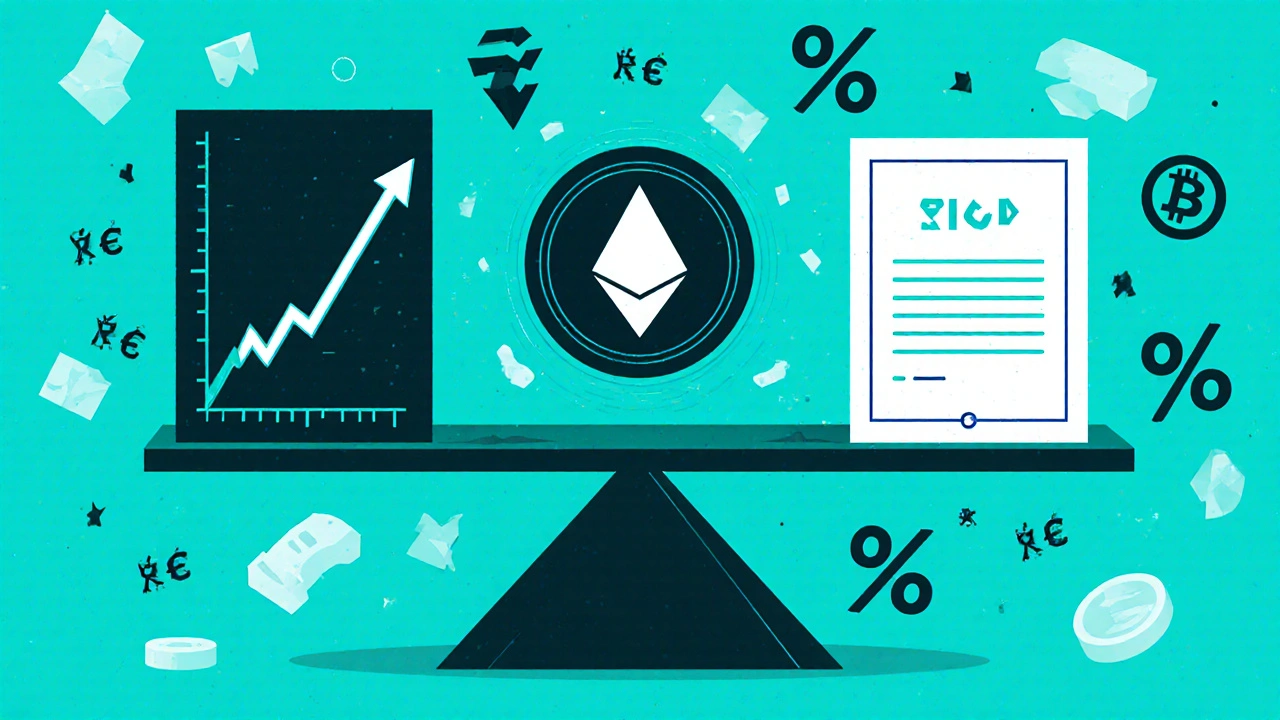For years, stablecoins like USDT and USDC have been the backbone of crypto trading-simple, reliable, and backed by actual dollars in bank accounts. But what if you could have a dollar-pegged token that doesn’t rely on banks at all? That’s the promise of synthetic stablecoins. Unlike traditional models, they don’t hold cash reserves. Instead, they use smart contracts, derivatives, and complex hedging to mimic the value of a dollar-without ever touching one.
How Synthetic Stablecoins Work (Without Holding Dollars)
Think of synthetic stablecoins as digital twins of the U.S. dollar. They track its value, but they’re built entirely on-chain. The magic happens through three main methods.
The first is over-collateralization, used by MakerDAO’s GHO. If you want to mint $100 worth of GHO, you need to lock up at least $150 in ETH or other crypto. That 50% buffer absorbs price swings. If ETH drops 20%, the system still has enough collateral to keep GHO pegged to $1.
The second method, pioneered by Ethena’s USDe, is delta hedging. You deposit ETH, and the protocol automatically sells an equivalent amount of ETH on futures markets. So if you put in $1,000 in ETH, it shorts $1,000 in ETH futures. When ETH goes up, your deposit gains value-but your short position loses the same amount. When ETH drops, your deposit loses-but your short gains. The two cancel out. The result? A stable dollar value. And because the protocol earns funding rates from those futures trades, users get paid yield-around 12-15% APY in 2023.
The third approach, used by Curve’s crvUSD, is a soft-liquidation system. It doesn’t instantly liquidate your collateral if prices dip. Instead, it triggers a gradual reduction in your position when collateral falls below 110%, and only fully liquidates if it hits 103%. This gives users breathing room during volatility.
All three models rely on price oracles-mostly Chainlink-to know the real-time value of collateral. If the oracle fails, the system breaks. That’s why most synthetic stablecoins only work on Ethereum-compatible chains, where oracles are mature and liquid markets exist.
Why Synthetic Stablecoins Are Different From USDC and DAI
USDC and USDT are simple: one dollar in a bank, one token on-chain. But that means they’re vulnerable to bank freezes, regulatory pressure, or political risk. If the U.S. government blocks a bank holding USDC reserves, those tokens could be frozen. Synthetic stablecoins don’t have that problem. They’re censorship-resistant by design.
DAI, MakerDAO’s older crypto-backed stablecoin, also avoids banks. But it doesn’t generate yield. If you hold DAI, you earn nothing. USDe, on the other hand, pays you. That’s because it’s not just a store of value-it’s a financial instrument. The yield comes from the perpetual futures market, where traders pay each other to hold long or short positions. The protocol captures that flow and distributes it to users.
Compare that to TerraUSD (UST), the algorithmic stablecoin that collapsed in 2022. UST had no collateral. It relied on an unstable token swap mechanism to maintain its peg. When confidence dropped, it spiraled into a death spiral. Synthetic stablecoins don’t make that mistake. They use real collateral and active hedging. Even during the 2023 regional banking crisis, USDe stayed within 0.5% of $1, while some centralized stablecoins briefly wobbled.

The Real-World Numbers: Who’s Using Them and How Much?
As of September 2024, the total stablecoin market sits at $150 billion. USDT leads with $102 billion. USDC is second at $34.7 billion. DAI holds about $13.6 billion. Then comes USDe-$3.2 billion. That’s just 2.1% of the total, but it’s growing fast.
USDe went from $0 to $3.2 billion in 18 months. That’s a 38.7% monthly growth rate. Ethena’s Discord server grew from 5,000 members to over 42,000 in the same time. Reddit threads about USDe’s performance during volatility now have hundreds of replies. Most users say they’re satisfied. One user wrote: “Used USDe to hedge my ETH during the March 2023 crash. It held at 99.8% while USDC dipped. Gas fees were brutal, though.”
But it’s not all smooth sailing. During extreme moves-like a 15% ETH drop in 10 minutes-crvUSD’s soft-liquidation system triggered unexpectedly. One user lost $1,200 because their position was reduced too aggressively. That’s the trade-off: complexity for yield.
The Risks: Oracle Failures, Liquidations, and Regulation
Every system has weak points. For synthetic stablecoins, the biggest is oracle dependence. If Chainlink or another oracle feeds bad data-say, reporting ETH at $2,000 when it’s really $1,800-the whole system can be exploited. NIST’s 2023 security report found that all synthetic stablecoin protocols failed stress tests simulating a 30% price move in five minutes.
Liquidation risks are real too. If collateral drops too fast, the system may not react in time. That’s why Ethena and MakerDAO now use dynamic collateral ratios that adjust based on market volatility. But they’re not perfect.
Then there’s regulation. The SEC has signaled that synthetic stablecoins might be classified as securities because they generate yield. Gary Gensler warned in 2023 that their mechanisms “could fall under securities laws.” The EU’s MiCA framework already classifies them as “asset-referenced tokens,” requiring strict capital rules. In the U.S., no clear rules exist yet-but lawmakers are watching.
And then there’s competition. Central banks are testing digital currencies. Over 130 countries are exploring CBDCs. If the U.S. launches a digital dollar, will anyone still need USDe?

Who Should Use Synthetic Stablecoins?
They’re not for beginners. You need to understand collateral ratios, derivatives, and gas fees. The average user takes 8-12 weeks to feel comfortable using them, according to CoinDesk’s survey.
If you’re experienced in DeFi and want:
- A dollar-pegged asset that can’t be frozen by banks
- Passive yield without staking or locking up tokens long-term
- Exposure to crypto without directional risk (thanks to hedging)
Then synthetic stablecoins like USDe or GHO are worth exploring.
But if you just want to hold dollars in crypto form-without complexity, risk, or yield-stick with USDC. It’s boring. But it works.
The Future: Bitcoin Integration and Institutional Interest
The next big move for synthetic stablecoins is expansion beyond Ethereum. Ethena plans to launch on Bitcoin Layer 2 networks by the end of 2024. That could open the door to millions of Bitcoin holders who’ve never touched DeFi.
Institutional interest is rising too. A 2024 Deloitte survey found 68% of traditional finance firms are interested in synthetic stablecoins for cross-border payments. Why? Because they’re faster, cheaper, and don’t rely on correspondent banking.
ARK Invest predicts synthetic stablecoins could hit $50 billion in market cap by 2027. That’s 15-20% of the total stablecoin market. More conservative analysts say 5-8%. Either way, they’re not going away.
The question isn’t whether they’ll survive. It’s whether they’ll scale without breaking.
Are synthetic stablecoins safer than USDT or USDC?
It depends on what you’re worried about. USDT and USDC are safer from technical failure-they’re backed by cash and audited. But they’re vulnerable to bank freezes or government action. Synthetic stablecoins like USDe can’t be frozen by banks, but they can fail if the smart contract or oracle breaks. So you’re trading counterparty risk for smart contract risk.
Do synthetic stablecoins really pay yield?
Yes. USDe, for example, earns yield from Ethereum perpetual futures funding rates. In 2023, that averaged 12.7% annually. That’s not interest from a bank-it’s money paid by traders who want to hold long positions. The protocol takes a cut and distributes the rest to users. It’s real, but it’s not guaranteed. If funding rates drop, so does your yield.
Can I lose money using synthetic stablecoins?
Absolutely. If your collateral crashes too fast, you can get liquidated. crvUSD’s soft-liquidation system once wiped out $1,200 for a user during a 15% ETH drop in 10 minutes. Gas fees can also eat into profits-minting or redeeming can cost $15-$50 on Ethereum. And if the oracle feeds wrong data, the system can be hacked. It’s not risk-free.
What’s the difference between GHO and USDe?
GHO uses over-collateralization: you lock up $150 in ETH to get $100 in GHO. It doesn’t generate yield. USDe uses delta hedging: you deposit ETH and the protocol shorts an equal amount on futures. It generates yield from funding rates. GHO is simpler but less efficient. USDe is more complex but pays you.
Are synthetic stablecoins regulated?
Not clearly in the U.S. The SEC has hinted they might be securities because they generate yield. The EU’s MiCA framework already classifies them as asset-referenced tokens, requiring capital reserves and disclosures. In the U.S., no final rules exist yet-but regulators are watching closely. If you’re using them, assume rules will change.
Can I use synthetic stablecoins on my phone?
Yes, but it’s not easy. You need a wallet like MetaMask, access to a DeFi platform like Ethena’s or Maker’s dashboard, and enough ETH to pay gas fees. There are no simple apps like Coinbase for this yet. Most users still rely on desktop interfaces and Discord support.
What happens if Ethereum goes down?
Most synthetic stablecoins are built on Ethereum or EVM-compatible chains. If Ethereum fails, they fail too. That’s why Ethena is working on Bitcoin L2 integrations-to reduce reliance on Ethereum. But for now, you’re betting on Ethereum’s long-term survival.
Is it worth it to use synthetic stablecoins in 2025?
If you’re already active in DeFi and understand the risks, yes. The yield is attractive, and the censorship resistance is valuable. But if you’re new to crypto, stick with USDC. Synthetic stablecoins are powerful tools-but they’re not for everyone. They’re for those who want to build a decentralized financial system, not just use one.



ANAND BHUSHAN
November 26, 2025 AT 04:15Been holding USDe for 6 months. Gas fees still suck but the yield makes it worth it.
Nalini Venugopal
November 26, 2025 AT 11:59So many people don’t realize synthetic stablecoins aren’t magic-they’re just complex financial engineering wrapped in a blockchain. The yield isn’t free money, it’s paid by leveraged traders betting against the market. If funding rates drop to zero, so does your APY. And don’t even get me started on oracle risks. Chainlink isn’t infallible. One glitch and your entire position gets wiped. I’ve seen it happen. It’s not theoretical.